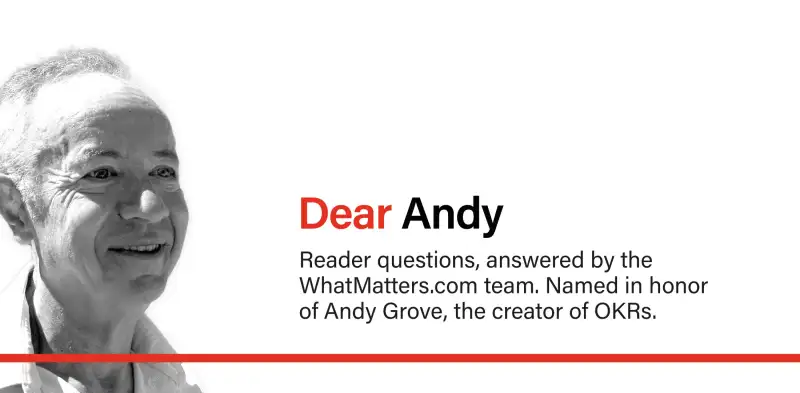Dear Andy,
I’m getting tripped up over the quarterly/90-day time span that’s recommended for an OKR cycle. As I look at some of the examples on the What Matters website, I envision many of them as requiring more than 90 days. (Even though I did hear Ryan Panchadsaram say in one of the podcasts to have a “North Star” – a larger goal.)
If I follow the North Star concept – then do I chunk up the Objectives in terms of a journey to the North Star? I could use some additional guidance on how to proceed with the 90-day time span.
Thanks in advance for your feedback,
Kathy

Hi Kathy!
Thanks for writing in.
Your question is one we hear often, so you’re not alone in getting tripped up on OKR cadences.
We recommend choosing the cadence that mirrors your company’s natural rhythms. For most organizations, a 90-day OKR cycle that aligns with those “Q’s” we all know and love works best. But for others, a different cadence is required. Think of a university whose school year runs from September through June, or a professional sports team whose year is split up into in-season and off-season. Even John Doerr’s firm, Kleiner Perkins, uses three cycles per year: the beginning of the year, the middle of the year, and “everything we have to get done before the end of the year.”
No matter what cadence you pick, though, make sure everyone in the organization is using the same one. It makes it easier to agree on how far and how fast everyone needs to get on shared priorities.
Second, you are absolutely right that some OKRs require more than 90 days. That’s why we encourage teams to set organization-wide annual goals, called North Stars.
As far as the North Star/90-day relationship, think of it like a Russian doll. First you have your company mission, which can last anywhere from five years to generations. Nestled within that, you have annual North Star Objectives which last, you guessed it, one year. Within those, you have shorter-term OKRs, which last for one cycle at the cadence that best suits your organization.
Here’s an example. Let’s say you work for a sustainability company:
Mission: Reach a net-zero carbon emission economy by 2050.
Annual North Star: Remove 8 gigatons of C02 from the atmosphere by the end of this year.
Short-term Objective: Accelerate electric transport in the Global South.
See how that works? Each Objective informs the next, with all OKRs connecting to each other to achieve significant progress toward the mission.
Remember, some Objectives may take longer than a single cycle. But if it’s a high enough priority to be one of your OKRs, you can and should still make meaningful progress each cycle. If that’s the case, set Key Results that you can commit to meeting. If you fail to achieve the OKR, you may discover that the KRs you chose didn’t accurately measure the success of the Objective or that there’s room to improve how you operate. That’s valuable to perform better in the next cycle. Then carry it over and refine or replace your Key Results.
You also may learn that what you considered a priority in January no longer needs top-billing by the end of March. Whether you retain or remove the Objectives, shorter cadences allow teams to reflect on progress and adapt.
Thanks for writing in, Kathy, and best of luck to you on your OKR journey.
Sincerely,
Billy from the What Matters Team

